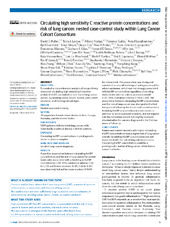Circulating high sensitivity C reactive protein concentrations and risk of lung cancer : Nested case-control study within Lung Cancer Cohort Consortium
| dc.contributor.author | Muller, David C. | en_US |
| dc.contributor.author | Larose, Tricia L | en_US |
| dc.contributor.author | Hodge, Allison | en_US |
| dc.contributor.author | Guida, Florence | en_US |
| dc.contributor.author | Langhammer, Arnulf | en_US |
| dc.contributor.author | Grankvist, Kjell | en_US |
| dc.contributor.author | Meyer, Klaus | en_US |
| dc.contributor.author | Cai, Qiuyin | en_US |
| dc.contributor.author | Arslan, Alan A. | en_US |
| dc.contributor.author | Zeleniuch-Jacquotte, Anne | en_US |
| dc.contributor.author | Albanes, Demetrius | en_US |
| dc.contributor.author | Giles, Graham G. | en_US |
| dc.contributor.author | Sesso, Howard D. | en_US |
| dc.contributor.author | Lee, I-Min | en_US |
| dc.contributor.author | Gaziano, J. Michael | en_US |
| dc.contributor.author | Yuan, Jian-Min | en_US |
| dc.contributor.author | Hoffman Bolton, Judith | en_US |
| dc.contributor.author | Buring, Julie E. | en_US |
| dc.contributor.author | Visvanathan, Kala | en_US |
| dc.contributor.author | Le Marchand, Loic | en_US |
| dc.contributor.author | Purdue, Mark P. | en_US |
| dc.contributor.author | Caporaso, Neil E. | en_US |
| dc.contributor.author | Midttun, Øivind | en_US |
| dc.contributor.author | Ueland, Per Magne | en_US |
| dc.contributor.author | Prentice, Ross L. | en_US |
| dc.contributor.author | Weinstein, Stephanie J. | en_US |
| dc.contributor.author | Stevens, Victoria L. | en_US |
| dc.contributor.author | Zheng, Wei | en_US |
| dc.contributor.author | Blot, William J. | en_US |
| dc.contributor.author | Shu, Xiao-Ou | en_US |
| dc.contributor.author | Zhang, Xuehong | en_US |
| dc.contributor.author | Xiang, Yong-Bing | en_US |
| dc.contributor.author | Koh, Woon-Puay | en_US |
| dc.contributor.author | Hveem, Kristian | en_US |
| dc.contributor.author | Thomson, Cynthia A. | en_US |
| dc.contributor.author | Pettinger, Mary | en_US |
| dc.contributor.author | Engström, Gunnar | en_US |
| dc.contributor.author | Brunnström, Hans | en_US |
| dc.contributor.author | Milne, Roger L. | en_US |
| dc.contributor.author | Stampfer, Meir J. | en_US |
| dc.contributor.author | Han, Jiali | en_US |
| dc.contributor.author | Johansson, Mikael | en_US |
| dc.contributor.author | Brennan, Paul | en_US |
| dc.contributor.author | Severi, Gianluca | en_US |
| dc.contributor.author | Johansson, Mattias | en_US |
| dc.date.accessioned | 2019-12-03T08:58:03Z | |
| dc.date.available | 2019-12-03T08:58:03Z | |
| dc.date.issued | 2019-01-03 | |
| dc.Published | Muller DC, Larose TL, Hodge A, Guida F, Langhammer A, Grankvist K, Meyer K, Cai Q, Arslan AA, Zeleniuch-Jacquotte A, Albanes D, Giles GG, Sesso HD, Lee I, Gaziano JM, Yuan J, Hoffman Bolton J, Buring JE, Visvanathan K, Le Marchand L, Purdue MP, Caporaso NE, Midttun Ø, Ueland PM, Prentice RL, Weinstein SJ, Stevens VL, Zheng W, Blot WJ, Shu X, Zhang X, Xiang Y, Koh W, Hveem K, Thomson CA, Pettinger M, Engström G, Brunnström H, Milne RL, Stampfer MJ, Han J, Johansson M, Brennan P, Severi G, Johansson M. Circulating high sensitivity C reactive protein concentrations and risk of lung cancer : Nested case-control study within Lung Cancer Cohort Consortium. BMJ-BRITISH MEDICAL JOURNAL. 2019;364:k4981:1-9. | eng |
| dc.identifier.issn | 1756-1833 | |
| dc.identifier.uri | https://hdl.handle.net/1956/21045 | |
| dc.description.abstract | Objectives: Inflammation may play an important role in lung cancer pathogenesis. Previous studies have suggested an association between C-reactive protein (CRP) as a marker of inflammation, and risk of lung cancer, but have lacked power to comprehensively investigate associations by smoking status and histological subtype. Our objective was to conduct a comprehensive analysis of prospectively measured circulating high-sensitivity CRP (hs-CRP) concentration and risk of lung cancer overall, by smoking status (current, former and never smokers), and histological sub-type. Design: Pooled analysis of prospective case-control studies nested within 20 population cohort studies. Setting: Population-based cohort studies in the Asia, Europe, Australia, and the United States. Participants: 5299 incident lung cancer cases, with individually incidence-density matched controls. Exposure: Circulating hs-CRP concentrations in pre-diagnostic serum/plasma samples. Main Outcome Measure: Incident lung cancer diagnosis. Results: We observed a positive association between circulating hs-CRP concentration and risk of lung cancer for current (OR per doubling in hs-CRP [ORlog2CRP]: 1.09, 95% CI: 1.05 to 1.13) and former smokers (ORlog2CRP 1.09, 95% CI: 1.04 to 1.14), but not never smokers (p-interaction <0.01). This association was strong and consistent across all histological subtypes, with the exception of adenocarcinoma, which was not strongly associated with risk regardless of smoking status (ORlog2CRP adenocarcinoma overall: 0.97, 95%CI: 0.94 to 1.01). Among current and former smokers, the associations were strongest within the first two years of follow-up. Including hs-CRP in a risk model in addition to smoking-based variables did not improve risk discrimination overall, but slightly improved discrimination for cancers diagnosed in the first two years of follow-up. Conclusions: Ever smokers with higher circulating hs-CRP concentrations had higher risk of lung cancer overall. hs-CRP was not associated with risk of lung adenocarcinoma. Circulating hs-CRP concentration may be a pre-diagnostic marker of lung cancer rather than a causal risk factor. | en_US |
| dc.language.iso | eng | eng |
| dc.publisher | BMJ Publishing Group | eng |
| dc.rights | Attribution CC BY 4.0 | eng |
| dc.rights.uri | http://creativecommons.org/licenses/by/4.0/ | eng |
| dc.title | Circulating high sensitivity C reactive protein concentrations and risk of lung cancer : Nested case-control study within Lung Cancer Cohort Consortium | en_US |
| dc.type | Peer reviewed | |
| dc.type | Journal article | |
| dc.date.updated | 2019-09-06T11:24:16Z | |
| dc.description.version | publishedVersion | en_US |
| dc.rights.holder | Copyright 2019 BMJ Publishing Group | |
| dc.identifier.doi | https://doi.org/10.1136/bmj.k4981 | |
| dc.identifier.cristin | 1627037 | |
| dc.source.journal | BMJ (British Medical Journal) | |
| dc.relation.project | Norges forskningsråd: 267776/H10 |

